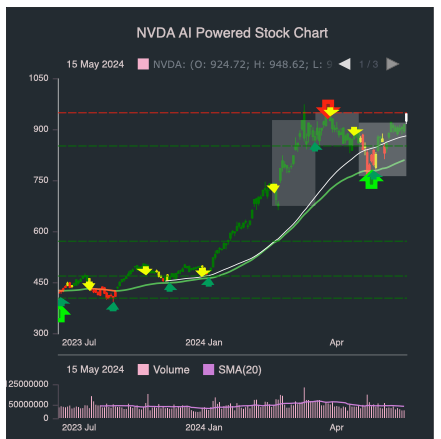20 Best Suggestions For Picking AI Stock Trading Websites
20 Best Suggestions For Picking AI Stock Trading Websites
Blog Article
Top 10 Tips For Evaluating The Integration And Compatibility Of Ai Analysis And Prediction Of Stocks Trading Platforms
AI stock trading platforms that can predict and analyze stocks based on AI should be compatible with each other. A platform that seamlessly integrates with your existing tools such as systems, workflows, and processes can significantly enhance efficiency and productivity. These are the top 10 guidelines for assessing the integration and compatibility of these platforms:
1. Check Brokerage Integration
Supported brokers: Ensure the platform works with your preferred brokerage account or trading account.
Trade Execution: Verify whether the platform allows direct trade execution by the integrated broker.
Account synchronization Check whether the platform lets you sync your account balances in real-time as well as positions and transactions.
2. Examine the API Availability
API access - Check that the platform includes an API that allows developers to develop customized tools or automate workflow flow.
API documentation: Make sure that the API is well-documented and includes clear examples and use cases.
Rate limits: Check whether there are acceptable rates for the API and if it is able to accommodate the anticipated volume of usage.
3. Assessment of Integration Tools from Third Parties
Popular Tools: Make sure the platform has integrations with other tools, such as Google Sheets and Excel.
Data export/import. Be sure your platform can import or export data from/to any other tool.
Plugins/extensions : Verify that the platform allows for plugins or extensions. They add features.
4. Test Compatibility with Operating Systems
Desktop compatibility. Check that your preferred operating systems (Windows, macOS, Linux) are supported.
Mobile compatibility - Check to see if the platform comes with a mobile version available for iOS as well as Android.
Web-based access: Determine that the platform can be access via a browser on the web to allow for greater flexibility.
5. Assessment of the Data Integration Capabilities
Data sources. Check that the platform is equipped with several data integrations (e.g. data providers for market, social media sentiment and news feeds).
Real-time feeds of data Check if the platform allows for real-time integration of data in order to offer up-to-date analysis.
Import historical data: Verify if the platform permits importing historical data to analyze or backtest.
6. Cloud and On Premise Compatibility
Cloud-based platforms: Make sure the platform can be accessed from anywhere that has an internet connection.
Solutions on-premise. If you are looking to deploy on-premise be sure to check whether your platform permits it.
Hybrid solutions: See whether the platform has an hybrid model that combines cloud capabilities and on-premise ones.
7. Verify Cross Platform Synchronization
Device synchronization. Make sure that the platform synchronizes data and settings across devices (desktops/laptops/mobiles/tablets).
Make sure that any changes made to one device immediately reflect on other devices.
Check the platform to see whether it permits data or functionality access even when you're offline.
8. Evaluate Compatibility with Trading Strategies
Algorithmic or automated trading: Ensure that the trading platform supports these strategies.
Custom indicators: Check if the platform allows the use of custom technical indicators or scripts.
Strategy backtesting: Check whether the platform can be used for backtesting trading strategies using historical information.
9. Examine Security and Compliance
Data encryption: Make sure the platform is using encryption for data that is in transit and at rest.
Verify that the platform offers security-grade authentication options like two-factor authentication.
Regulation compliance: Determine if the platform is compliant with applicable regulations (e.g., GDPR, FINRA, SEC).
10. Test Scalability and Performance
Scalability - Make sure that the platform you select can accommodate your increasing demands in terms of both users and data.
Performance during load conditions: Verify whether the platform continues to be responsive during high-volatility market conditions.
Utilization of resources: Make sure the platform makes efficient use of system resources such as memory, CPU and bandwidth.
Bonus Tips:
User feedback: Use reviews from customers to assess the capabilities of integration on platforms.
Free trial period: You are able to use a demo or free trial to check the platform's compatibility with your current workflows and tools.
Customer Support: The platform needs to provide a solid support service when it comes to integration issues.
You can test the integration, compatibility, and efficiency of AI trading platforms for stocks by following these tips. Follow the best ai for stock trading blog for site recommendations including chatgpt copyright, best ai for trading, ai for trading, ai for stock trading, ai investing, ai trading tools, best AI stock trading bot free, ai investment platform, ai investment platform, investing ai and more.
Top 10 Tips For Evaluating The Speed And Latency Of Ai Platform For Analyzing And Predicting Trading Stocks
Speed and latency are crucial aspects to consider when looking at AI stock prediction and analysis platforms, particularly for active traders, algorithmic traders, and high-frequency traders. Even millisecond delays can impact on the success of the trade. These are the top 10 tips for assessing the latency and speed of these platforms.
1. Examine the Real-Time Data Feeds
Speed of data delivery - Make sure that the platform will provide real-time data with a minimum delay (e.g. the sub-millisecond delay).
Verify the source's proximity to most important exchanges.
Data compression: Determine whether your platform is using effective data compression techniques to speed up data delivery.
2. Test Trade Execution Speed
Processing time for orders: Check how quickly the platform processes and executes trades when you submit an order.
Direct market access: Make sure that the platform permits direct orders to be made to the exchange.
Make sure you have a detailed report on the execution that includes timestamps as well as confirmations of your order.
3. Assess Platform Responsiveness
User interface (UI) speed: Test how fast the UI on your platform responds to inputs (e.g. click buttons or loading charts).
Chart updates: Verify that visualisations and charts update in real-time, with no lag.
Performance of mobile apps If you are using a mobile app be sure that it is running similarly to the desktop version.
4. Look for infrastructure that is not low-latency.
Server location Check that the platform is running a low-latency server located near exchanges and financial hubs.
Co-location: If the platform allows co-location, then you can place your trading algorithms on servers close to the exchange.
High-speed networks - Make sure that the platform utilizes fiber-optic high-speed network or other low-latency techniques.
5. Backtesting and testing the speed of simulations.
Historical processing of data: Find out how fast your platform processes and processes historical data.
Simulation latency: Make sure that the platform is able to simulate trading in real-time without any noticeable delay.
Parallel processing: Check if your platform uses distributed computing or parallel processing to speed up calculations.
6. Evaluation of Latency in API
API response time: Measuring how quickly the platform’s API responds (e.g. fetching market data or placing orders).
Rate limits. Check to see what limits are appropriate on the API. This will help prevent delays in high-frequency transactions.
WebSockets support: Verify that your platform is using WebSockets protocols for low-latency real-time streaming of data.
7. Test Platform Stability Under Load
High-volume trading Test the platform's ability to respond and stability, you can simulate high-volume scenarios.
Test the platform in times when there is a lot of volatility on the market to see if it is able to handle sudden changes in price.
Test your strategy for stress: Find out if the platform allows you to test your strategy in extreme conditions.
8. Evaluation of Connectivity and Network
Internet speed requirements: Ensure that your connection is at the recommended speed of your platform.
Redundant Connections: To avoid delay, verify that your platform supports redundant internet connections.
VPN latency. If you're using the VPN be sure to check if it introduces significant latency.
9. Make sure to check for speed enhancement features
Pre-trade Analyses: Make sure whether the platform offers the pre-trade analysis in order to maximize execution speed and order processing.
Smart order routing (SOR) Check that the platform is using SOR to identify the fastest and cost-effective execution venues.
Latency monitoring: Check if the platform offers tools for monitoring and analyzing the speed of latency in real time.
Check out the feedback of users and benchmarks
User reviews: Conduct user research to evaluate the platform's performance in terms of latency and speed.
Benchmarks from third parties Check out independent reviews or benchmarks comparing the performance of the platform to those of its competitors.
Case studies: See if the platform offers case studies or testimonials that showcase its abilities to provide low-latency.
Bonus Tips
Trial period: Try an unpaid trial or demo to evaluate the platform's performance and latency in real-world scenarios.
Customer support: determine if the platform has assistance with issues related to latency or for optimization.
Hardware requirements: Find out if the platform needs specific hardware for optimal performance.
These guidelines will assist you assess the speed and latencies of AI platform for stock prediction and analysis. So, you'll be able to choose a platform which meets your needs while minimizing delay. Low latency is crucial for high-frequency traders and algorithmic traders. Even the smallest delay can have a huge impact on profits. Have a look at the best ai investment tools tips for more recommendations including ai tools for trading, best AI stock prediction, investing with ai, stock predictor, ai options, chart ai trading, ai options, stock predictor, stock trading ai, best stock prediction website and more.